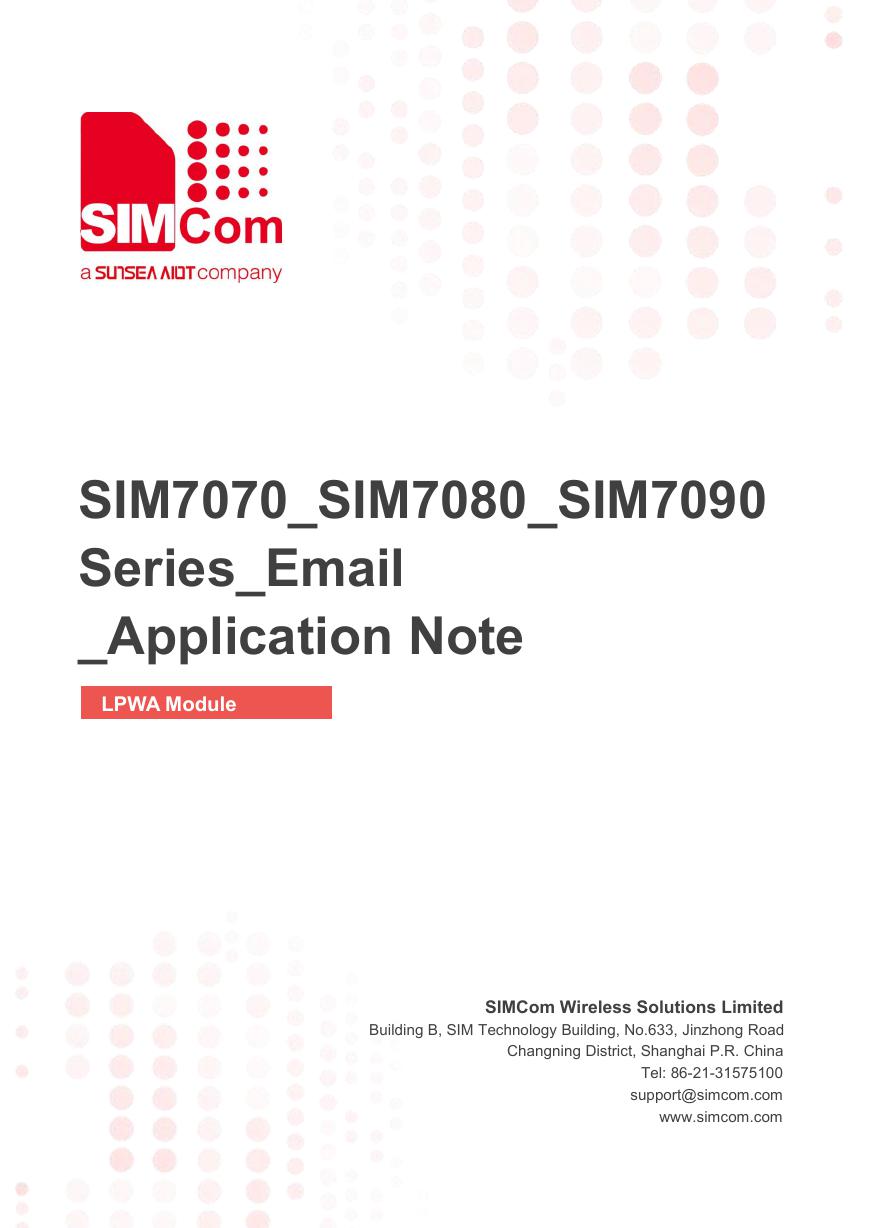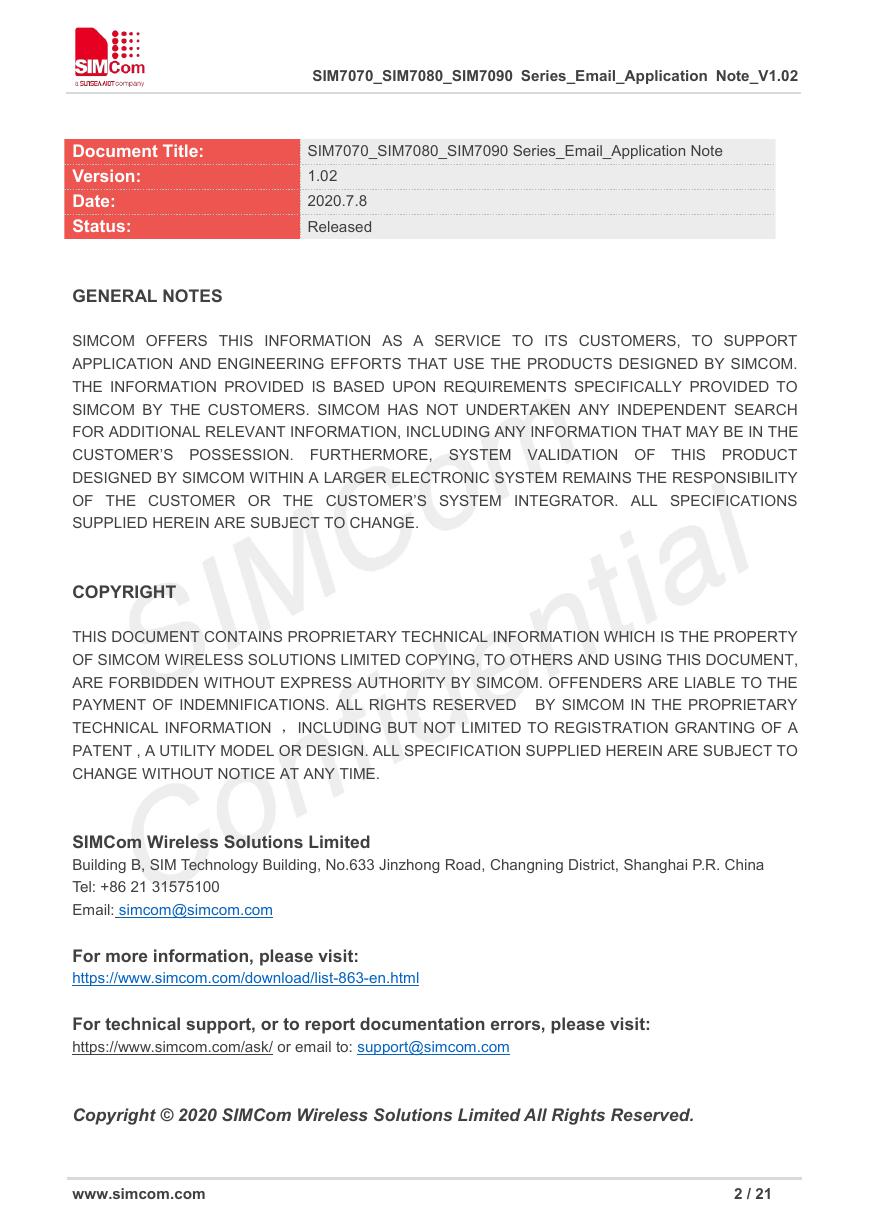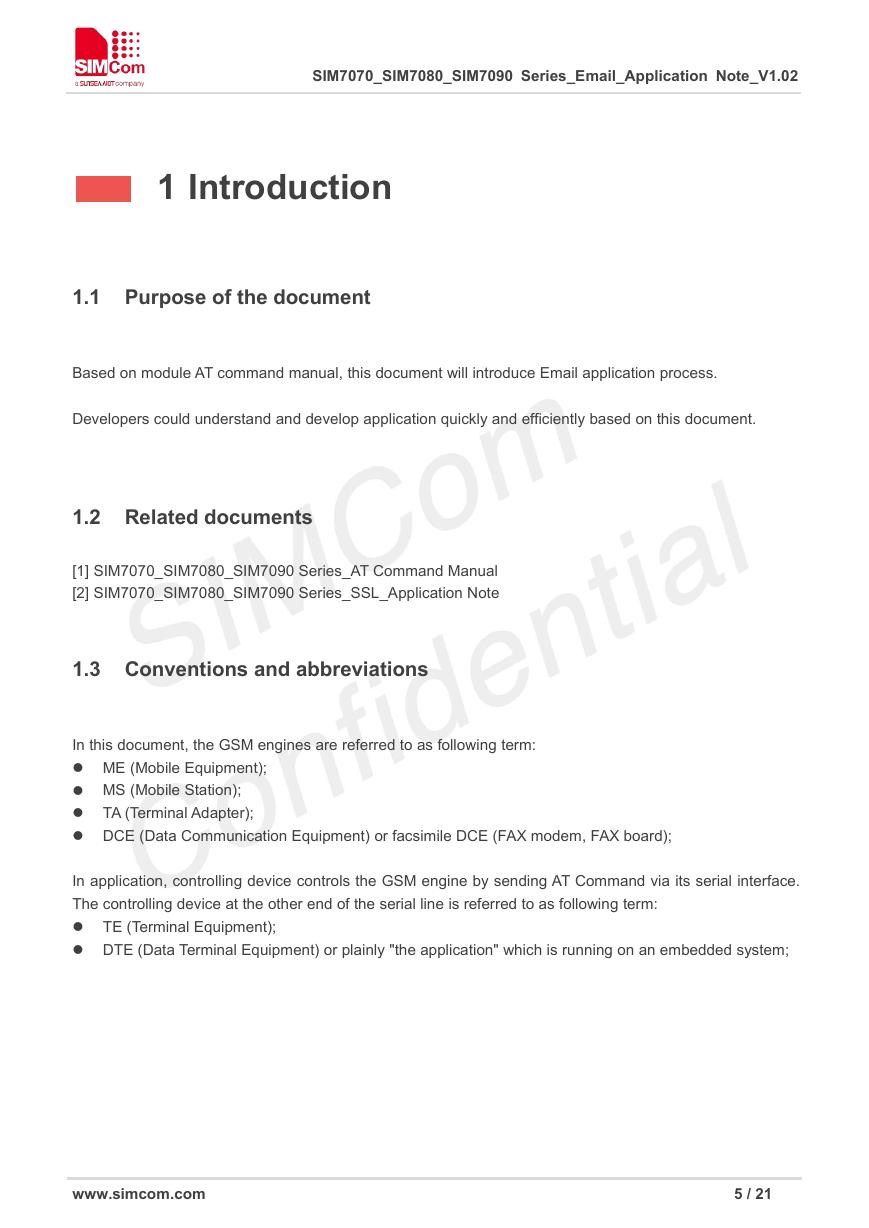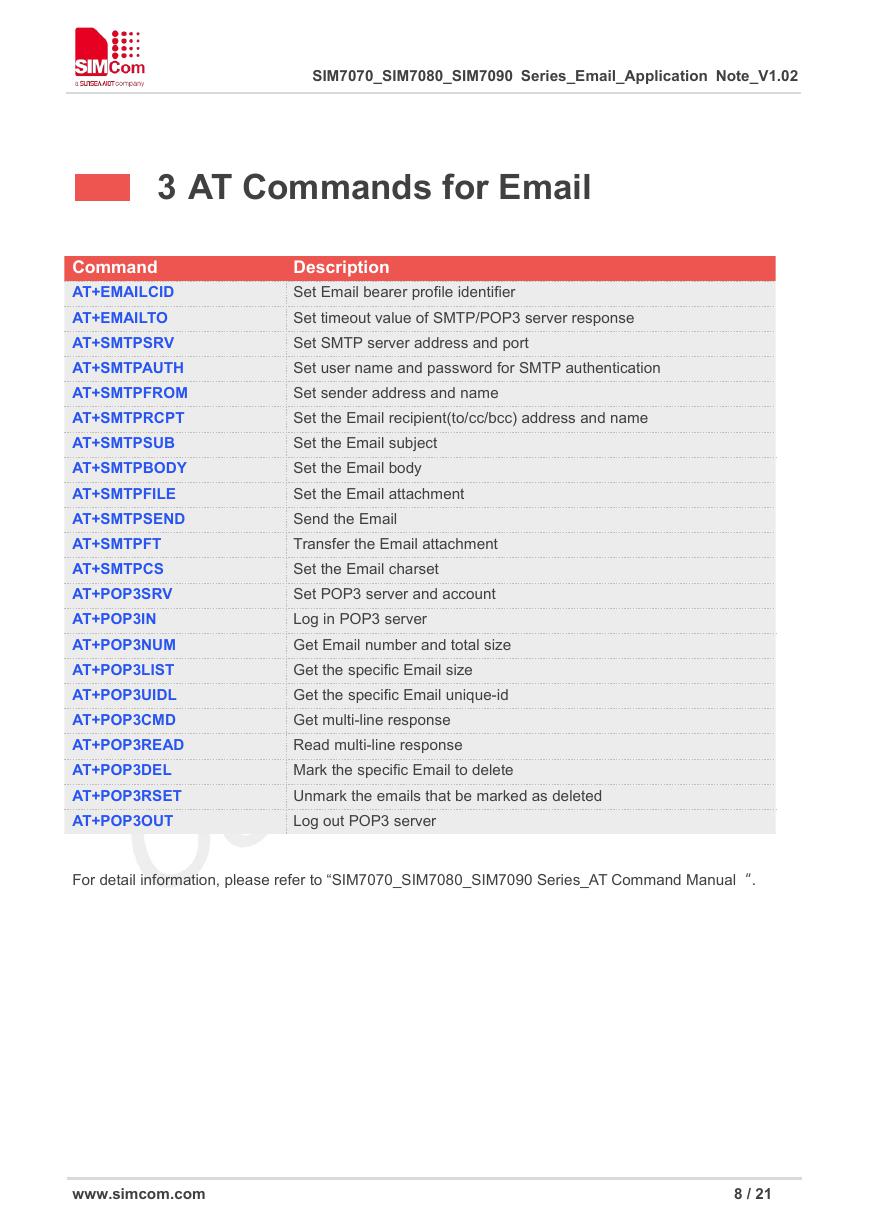SIM7070_SIM7080_SIM7090
Series_Email
_Application Note
LPWA Module
SIMCom Wireless Solutions Limited
Building B, SIM Technology Building, No.633, Jinzhong Road
Changning District, Shanghai P.R. China
Tel: 86-21-31575100
support@simcom.com
www.simcom.com
�
SIM7070_SIM7080_SIM7090 Series_Email_Application Note_V1.02
SIM7070_SIM7080_SIM7090 Series_Email_Application Note
1.02
2020.7.8
Released
Document Title:
Version:
Date:
Status:
GENERAL NOTES
SIMCOM OFFERS THIS INFORMATION AS A SERVICE TO ITS CUSTOMERS, TO SUPPORT
APPLICATION AND ENGINEERING EFFORTS THAT USE THE PRODUCTS DESIGNED BY SIMCOM.
THE INFORMATION PROVIDED IS BASED UPON REQUIREMENTS SPECIFICALLY PROVIDED TO
SIMCOM BY THE CUSTOMERS. SIMCOM HAS NOT UNDERTAKEN ANY INDEPENDENT SEARCH
FOR ADDITIONAL RELEVANT INFORMATION, INCLUDING ANY INFORMATION THAT MAY BE IN THE
CUSTOMER’S POSSESSION. FURTHERMORE, SYSTEM VALIDATION OF THIS PRODUCT
DESIGNED BY SIMCOM WITHIN A LARGER ELECTRONIC SYSTEM REMAINS THE RESPONSIBILITY
OF THE CUSTOMER OR THE CUSTOMER’S SYSTEM INTEGRATOR. ALL SPECIFICATIONS
SUPPLIED HEREIN ARE SUBJECT TO CHANGE.
COPYRIGHT
THIS DOCUMENT CONTAINS PROPRIETARY TECHNICAL INFORMATION WHICH IS THE PROPERTY
OF SIMCOM WIRELESS SOLUTIONS LIMITED COPYING, TO OTHERS AND USING THIS DOCUMENT,
ARE FORBIDDEN WITHOUT EXPRESS AUTHORITY BY SIMCOM. OFFENDERS ARE LIABLE TO THE
PAYMENT OF INDEMNIFICATIONS. ALL RIGHTS RESERVED BY SIMCOM IN THE PROPRIETARY
TECHNICAL INFORMATION ,INCLUDING BUT NOT LIMITED TO REGISTRATION GRANTING OF A
PATENT , A UTILITY MODEL OR DESIGN. ALL SPECIFICATION SUPPLIED HEREIN ARE SUBJECT TO
CHANGE WITHOUT NOTICE AT ANY TIME.
SIMCom Wireless Solutions Limited
Building B, SIM Technology Building, No.633 Jinzhong Road, Changning District, Shanghai P.R. China
Tel: +86 21 31575100
Email: simcom@simcom.com
For more information, please visit:
https://www.simcom.com/download/list-863-en.html
For technical support, or to report documentation errors, please visit:
https://www.simcom.com/ask/ or email to: support@simcom.com
Copyright © 2020 SIMCom Wireless Solutions Limited All Rights Reserved.
www.simcom.com
2 / 21
�
SIM7070_SIM7080_SIM7090 Series_Email_Application Note_V1.02
About Document
Version History
Owner
Date
2019.10.12 Wenjie.Lai
2020.2.26
2020.7.8
What is new
First Release
Yulong.Zheng Add SSL and examples
Wenjie.Lai
All
Version
V1.00
V1.01
V1.02
Scope
This document applies to the following products
Name
SIM7080G
SIM7070G/SIM7070E
SIM7070G-NG
SIM7090G
Type
CAT-M/NB
CAT-M/NB/GPRS
NB/GPRS
CAT-M/NB
Size(mm)
17.6*15.7 *2.3
24*24*2.4
24*24*2.4
14.8*12.8*2.0
Comments
N/A
N/A
N/A
N/A
www.simcom.com
3 / 21
�
SIM7070_SIM7080_SIM7090 Series_Email_Application Note_V1.02
2
Contents
About Document.................................................................................................................................. 3
Version History.........................................................................................................................................................3
Scope........................................................................................................................................................................ 3
Contents................................................................................................................................................. 4
Introduction.................................................................................................................................... 5
1
Purpose of the document...........................................................................................................................5
1.1
Related documents.....................................................................................................................................5
1.2
Conventions and abbreviations................................................................................................................ 5
1.3
Email Introduction...................................................................................................................... 6
Introduction...................................................................................................................................................6
2.1
Email Address..............................................................................................................................................6
2.2
Email Protocol..............................................................................................................................................7
2.3
3 AT Commands for Email............................................................................................................. 8
4 Bearer Configuration....................................................................................................................9
PDN Auto-activation....................................................................................................................................9
APN Manual Configuration......................................................................................................................10
5 Email Examples...........................................................................................................................12
Synchronize time...................................................................................................................................... 12
5.1
Send an Email........................................................................................................................................... 12
5.2
Send an Email with an attachment........................................................................................................ 13
5.3
Send a UTF-8 Email.................................................................................................................................14
5.4
Retrieve the Email.................................................................................................................................... 15
5.5
Delete the Email........................................................................................................................................16
5.6
Get the Email’s size and unique-id........................................................................................................ 17
5.7
Email Send Encrypted Mail with Normal Port......................................................................................18
5.8
Email Send Encrypted Mail with Encryption Port................................................................................19
5.9
5.10 Email Receive Encrypted Mail with Encryption Port...........................................................................20
4.1
4.2
www.simcom.com
4 / 21
�
SIM7070_SIM7080_SIM7090 Series_Email_Application Note_V1.02
1 Introduction
1.1 Purpose of the document
Based on module AT command manual, this document will introduce Email application process.
Developers could understand and develop application quickly and efficiently based on this document.
1.2 Related documents
[1] SIM7070_SIM7080_SIM7090 Series_AT Command Manual
[2] SIM7070_SIM7080_SIM7090 Series_SSL_Application Note
1.3 Conventions and abbreviations
In this document, the GSM engines are referred to as following term:
ME (Mobile Equipment);
MS (Mobile Station);
TA (Terminal Adapter);
DCE (Data Communication Equipment) or facsimile DCE (FAX modem, FAX board);
In application, controlling device controls the GSM engine by sending AT Command via its serial interface.
The controlling device at the other end of the serial line is referred to as following term:
TE (Terminal Equipment);
DTE (Data Terminal Equipment) or plainly "the application" which is running on an embedded system;
www.simcom.com
5 / 21
�
SIM7070_SIM7080_SIM7090 Series_Email_Application Note_V1.02
2 Email Introduction
2.1
Introduction
Electronic mail (email or e-mail) is a method of exchanging messages ("mail") between people using
electronic devices. Invented by Ray Tomlinson, email first entered limited use in the 1960s and by the
mid-1970s had taken the form now recognized as email. Email operates across computer networks, which
today is primarily the Internet. Some early email systems required the author and the recipient to both be
online at the same time, in common with instant messaging. Today's email systems are based on a
store-and-forward model. Email servers accept, forward, deliver, and store messages. Neither the users nor
their computers are required to be online simultaneously; they need to connect only briefly, typically to a
mail server or a webmail interface for as long as it takes to send or receive messages or to download it.
text-only communications medium,
Originally an ASCII
Internet email was extended by Multipurpose
Internet Mail Extensions (MIME) to carry text in other character sets and multimedia content attachments.
International email, with internationalized email addresses using UTF-8(which you can send Chinese email
body), has been standardized, but as of 2017 it has not been widely adopted.
The history of modern Internet email services reaches back to the early ARPANET, with standards for
encoding email messages published as early as 1973 (RFC 561). An email message sent in the early
1970s looks very similar to a basic email sent today.
2.2
Email Address
The format of an email address consists of three parts: User identifier + @ + domain name
The first part "USER" represents the account of the user's mailbox. For the same mail receiving server, this
account must be unique;
The second part "@" is a separator. @ is the symbol of "at", which means "at".
The third part is the domain name of the mail receiving server of the user mailbox.
The domain_name here is the identifier of
the mail
destination to which the mail must be delivered. Somebody is the email address on the domain. The suffix
generally represents the nature of the domain name and the region code. The domain name is really
the domain name of
is,
the domain name,
that
www.simcom.com
6 / 21
�
SIM7070_SIM7080_SIM7090 Series_Email_Application Note_V1.02
technically a mail switch, not a machine name.
2.3
Email Protocol
There are several common email protocols: SMTP, POP3, IMAP. These several protocols are defined by
the TCP / IP protocol family.
SMTP (Simple Mail Transfer Protocol): SMTP is mainly responsible for how the underlying mail system
transfers mail from one machine to another. The normal and startSSL port is 25, and the SSL port is 465.
POP (Post Office Protocol): The version is POP3. POP3 is a protocol for transmitting mail from an email box
to a local computer. The normal port is 110, and the SSL port is 995, no startSSL.
IMAP (Internet Message Access Protocol): The version is IMAP4, which is an alternative protocol to POP3.
It provides new functions of mail retrieval and mail processing, so that users can see the summary of the
title of the mail without downloading the body of the mail. The client software can operate on the mail and
folder directories on the server. The IMAP protocol enhances the flexibility of e-mail, and also reduces the
direct harm of spam to the local system, and at the same time saves users the time to check the e-mail. In
addition, the IMAP protocol can remember the user's operations on the mail in the offline state (such as
moving mail, deleting mail, etc.) will be automatically executed the next time the network connection is
opened. The normal port is 143, and the SSL port is 993, no startSSL.
Support for SSL connections is integrated into most popular email client programs.
In addition, many encryption technologies are also applied to the sending and receiving and reading of
e-mail. They can provide encryption strengths ranging from 128 to 2048 bits. Both unidirectional and
symmetric key encryption are widely supported
SIM7070_SIM7080_SIM7090 Series support SMTP and POP3 protocols.
www.simcom.com
7 / 21
�
SIM7070_SIM7080_SIM7090 Series_Email_Application Note_V1.02
3 AT Commands for Email
Command
AT+EMAILCID
AT+EMAILTO
AT+SMTPSRV
AT+SMTPAUTH
AT+SMTPFROM
AT+SMTPRCPT
AT+SMTPSUB
AT+SMTPBODY
AT+SMTPFILE
AT+SMTPSEND
AT+SMTPFT
AT+SMTPCS
AT+POP3SRV
AT+POP3IN
AT+POP3NUM
AT+POP3LIST
AT+POP3UIDL
AT+POP3CMD
AT+POP3READ
AT+POP3DEL
AT+POP3RSET
AT+POP3OUT
Description
Set Email bearer profile identifier
Set timeout value of SMTP/POP3 server response
Set SMTP server address and port
Set user name and password for SMTP authentication
Set sender address and name
Set the Email recipient(to/cc/bcc) address and name
Set the Email subject
Set the Email body
Set the Email attachment
Send the Email
Transfer the Email attachment
Set the Email charset
Set POP3 server and account
Log in POP3 server
Get Email number and total size
Get the specific Email size
Get the specific Email unique-id
Get multi-line response
Read multi-line response
Mark the specific Email to delete
Unmark the emails that be marked as deleted
Log out POP3 server
For detail information, please refer to “SIM7070_SIM7080_SIM7090 Series_AT Command Manual“.
www.simcom.com
8 / 21
�
















 V2版本原理图(Capacitive-Fingerprint-Reader-Schematic_V2).pdf
V2版本原理图(Capacitive-Fingerprint-Reader-Schematic_V2).pdf 摄像头工作原理.doc
摄像头工作原理.doc VL53L0X简要说明(En.FLVL53L00216).pdf
VL53L0X简要说明(En.FLVL53L00216).pdf 原理图(DVK720-Schematic).pdf
原理图(DVK720-Schematic).pdf 原理图(Pico-Clock-Green-Schdoc).pdf
原理图(Pico-Clock-Green-Schdoc).pdf 原理图(RS485-CAN-HAT-B-schematic).pdf
原理图(RS485-CAN-HAT-B-schematic).pdf File:SIM7500_SIM7600_SIM7800 Series_SSL_Application Note_V2.00.pdf
File:SIM7500_SIM7600_SIM7800 Series_SSL_Application Note_V2.00.pdf ADS1263(Ads1262).pdf
ADS1263(Ads1262).pdf 原理图(Open429Z-D-Schematic).pdf
原理图(Open429Z-D-Schematic).pdf 用户手册(Capacitive_Fingerprint_Reader_User_Manual_CN).pdf
用户手册(Capacitive_Fingerprint_Reader_User_Manual_CN).pdf CY7C68013A(英文版)(CY7C68013A).pdf
CY7C68013A(英文版)(CY7C68013A).pdf TechnicalReference_Dem.pdf
TechnicalReference_Dem.pdf